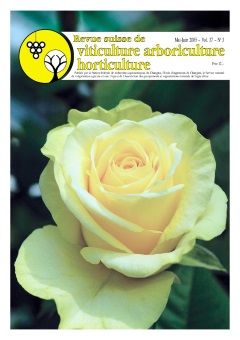
Issue 3 - May - June 2005
Abstract in open access
Humagne rouge is a grapevine variety originated from the Aosta valley (Italy) but it is primarily cultivated in the Valais (Switzerland). A grey form of this variety was observed for the first time in 2000 on a shoot of a Humagne rouge vine in the experimental vineyard of Agroscope RAC Changins at Leytron (VS). The grafting material resulting from this vine shoot was multiplied and introduced in the collection of the Centre viticole du Caudoz in Pully. The grey character of the berries could be confirmed in 2004 on all the bunches carried by the vines of third year. We propose to name this new varietal form «Humagne gris».
Key words: grapevine, Humagne rouge, Humagne gris.
Keywords:
E-Mail: dominique.maigre@bluewin.ch
Adress: Agora
Abstract in open access
The agricultural extension service of the French speaking part of Switzerland (Service romand de vulgarisation agricole, SRVA) calculates the production costs for the ten most frequent vine cultivation methods in Switzerland. These references let wine growers compare their individual results and adapt continuously their methods.
The present article studies the results development since 1997. In an average year, production costs are between 31 000 Sfr./ha for vines with spacing close to 2 m with high levels of mechanisation and 55 000 Sfr./ha for narrow vines without mechanisation.
Hourly labour costs, the main production factor, have increased. Labour needs have remained stable within the studied period. For certain jobs, such as tying or top cutting, an increase in mechanisation has permitted to diminish labour needs without direct increase of mechanisation costs. The particular meteorological conditions of 2003 induced a reduction of work hours in the vineyards with a density below 65 vines/a, whilst in denser vineyards, labour needs were less influenced.
Direct payments per surface paid by the state did not compensate the unit production costs increase induced by the reinforcement of yield limitations. Labour productivity (kg of grapes produced per hour worked) is decreasing since 1997. This deterioration concerns mainly very steep vineyards, where the possibilities of mechanisation are scarce or inexistent.
Rationalisation attempts, such as plots transformation or construction of access ramps for machines, did not compensate the costs increase in vineyards with light mechanisation. On the other hand, in tractor mechanised vineyards, rationalisation permitted a slight reduction in production costs. Possible technical changes in most Swiss wine regions are reaching quickly their limits. The technical adaptations should be combined with other initiatives such as increasing the product or site value.
Key words: vineyards cultivation methods, production costs, labour costs, unit production costs, economic analysis, references, steep vineyards, rationalisation, degree of mechanisation.
Keywords:
E-Mail: philippe.droz@agridea.ch
Adress: Agora
Abstract in open access
Biological control methods make their beginnings in ornamental crops. The acquisition of practical sampling methods for beneficial organisms and pests is necessary to enhance biological control on roses. The aim of this study was to validate simple sampling method for spider mites, one of its predators and whiteflies on roses grown in greenhouse.
The Nachmann function showed strong relations between the percentage of leaves, of the bended as well as of the commercial stems, occupied by at least one mobile stage of Tetranychus urticae and its predator Neoseiulus californicus, and their respective densities. For whitefly, the same type of relation with a high coefficient of correlation exists between the percentage of leaves of the commercial stems occupied by at least one adult and the respective density. For the whitefly larvae, the percentage of occupation and the density are also related.
These results allow to validate the use of a sampling method based on the percentage of occupation of leaves by mobile stages of spider mite, whitefly larvae and adults. Since the percentages of occupation of leaves by T. urticae and N. californicus on commercial and on bending stems were well correlated, monitoring of these two mites on the bending stems will be sufficient for practical use. Yellow sticky traps, as well examinated, can not be used to evaluate the evolution of the whitefly populations.
Key words: Tetranychus urticae, Trialeurodes vaporariorum, Neoseiulus californicus, sampling method, greenhouse roses.
Keywords:
E-Mail: celine.gilli@agroscope.admin.ch
Adress:

 Download of full issue
Download of full issue
 Download article
Download article